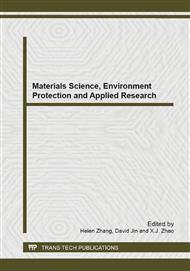p.119
p.124
p.129
p.133
p.137
p.141
p.145
p.155
p.159
Influences of Molding Pressure on Products Morphology and Carbonated Efficiency of Calcium Hydroxide
Abstract:
The products and carbonated efficiency were two major aspects on carbonation of waste mineral and the carbonated efficiency and products morphology would make a very big difference under the different molding pressures. The conditions of this study were as follows: water to solid ratio (W/S), CO2 pressure and mass fraction were 0.15, 0.2 MPa and 99.9%,respectively, and the molding pressures were ranged from 0 MPa to 8 MPa. After carbonation, the carbonated efficiency and microstructure were perform with CO2 mass gain degree and SEM, respectively. As the results, low molding pressure was beneficial to early carbonation and high molding pressure can improve later carbonation. The products morphology were became from rhombohedron to smooth ellipsoid with the molding pressure increased. The XRD pattern showed that only calcite was formed in this study.
Info:
Periodical:
Pages:
137-140
Citation:
Online since:
March 2014
Authors:
Price:
Сopyright:
© 2014 Trans Tech Publications Ltd. All Rights Reserved
Share:
Citation:


